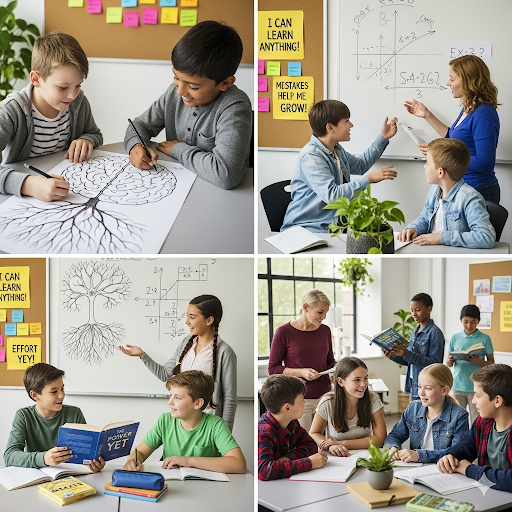
DISCOUNTED EDUCATION PRICING! CALL 1-877-891-8411. We Gladly Accept School Purchase Orders!

In education, one of the most powerful tools for success isn’t a new piece of technology, a fancy curriculum, or even access to unlimited resources—it’s mindset. The way students (and teachers) view intelligence, effort, and mistakes can completely reshape the learning experience. The difference between a student who gives up after a poor test grade and one who sees it as an opportunity to improve often comes down to mindset.
That’s why teaching and modeling a growth mindset in the classroom is one of the most effective ways to build resilience, encourage academic achievement, and prepare students for life beyond school.
A growth mindset is the belief that intelligence, skills, and abilities can be developed through effort, persistence, and effective strategies. In contrast, a fixed mindset suggests that talent and intelligence are static traits—you’re either “smart” or you’re not.
📌 Quick snippet: A growth mindset shifts thinking from “I’m just not good at math” to “I can improve at math with practice and new strategies.”
For students, a growth mindset means they see challenges and mistakes as opportunities to learn instead of as proof they “aren’t smart.” For teachers, it’s about fostering classrooms where effort, resilience, and curiosity are just as important as getting the correct answer.
📌 Snippet for schools: Teaching growth mindset isn’t just about raising test scores—it’s about raising resilient learners who are prepared for real life.
Teachers have the ability to model growth mindset every single day. Here are some strategies that can transform classroom culture:
Saying “You’re so smart” encourages a fixed mindset. Instead, try:
Mistakes are not a failure—they’re evidence that learning is happening. Share your own mistakes with students and what you learned from them.
Instead of letting students say “I can’t do this,” encourage them to add “yet.” This single word turns discouragement into possibility.
Ask students to reflect:
Students thrive when they can choose how to showcase their knowledge. Allow options like presentations, posters, podcasts, or digital projects. Having parents involved, is a great way of helping students achieve success.
📌 Snippet for teachers: Growth mindset is reinforced not in one lesson, but in how you structure every assignment, every reflection, and every classroom interaction.
Teachers can actively help students move from a fixed mindset to a growth mindset by being intentional about language, feedback, and classroom routines.
📌 Student snippet: “Your brain is like a muscle. The more you use it, the stronger it gets.”
Practical classroom activities can make growth mindset come alive:
📌 Quick activity snippet: Try a “FAIL of the Week” wall where students post something they struggled with and what they learned from it.
📌 Student tip: Write down one way you improved each day, even if it’s small. Over time, you’ll see real growth.
A growth mindset shouldn’t be a one-off lesson—it should be embedded in the culture of the school.
📌 Snippet for administrators: Growth mindset culture starts at the top. When schools celebrate resilience and persistence, students feel safe to take risks in their learning.
It’s important to clarify what growth mindset is not:
📌 Clarification snippet: Growth mindset is about pairing high expectations with the belief that every student can improve with effort and strategy.
Sometimes the best way to teach growth mindset is through storytelling. Share with your students the struggles of famous figures who succeeded not because of instant talent, but because of persistence:
📌 Snippet for classrooms: Sharing growth mindset stories inspires students to see that setbacks are not the end—they’re the beginning of resilience.
Growth mindset isn’t just for school—it’s a life skill. Students who adopt it early are better prepared for real-world challenges:
📌 Snippet for students: “Every expert you admire started as a beginner who failed, learned, and tried again.”
A growth mindset, as pioneered by psychologist Carol Dweck in her groundbreaking research on growth mindset vs fixed mindset, is far more than mere blind optimism or simply urging students to “just try harder” without guidance. Instead, it represents a transformative approach to learning that emphasizes fostering resilience in children, teaching effective strategies for improvement, and helping students reframe setbacks as valuable opportunities within the learning journey. By adopting this perspective, educators and learners alike can unlock the full potential of effort-based progress, leading to enhanced academic performance, emotional well-being, and lifelong adaptability.
For educators seeking practical ways to develop a growth mindset in the classroom, it begins with intentionally modeling growth mindset thinking on a daily basis. This can be achieved through thoughtful feedback that highlights effort and progress rather than innate talent, such as praising a student’s persistence in solving a challenging math problem instead of labeling them as “smart.” Incorporating growth mindset activities into classroom routines— like starting each day with reflective journaling on personal challenges and triumphs—can normalize the idea that intelligence and abilities are malleable. Moreover, teachers play a pivotal role in reshaping how we talk about mistakes, turning them into teachable moments by sharing their own experiences with failure and recovery. Strategies for teaching growth mindset to students might include collaborative group work where peers discuss overcoming obstacles, or integrating real-world examples of famous innovators who succeeded through iteration and perseverance, thereby overcoming fixed mindset barriers in education.
📌 Closing snippet: When schools adopt a culture of growth mindset, they don’t just create better students—they create lifelong learners ready for every challenge ahead.